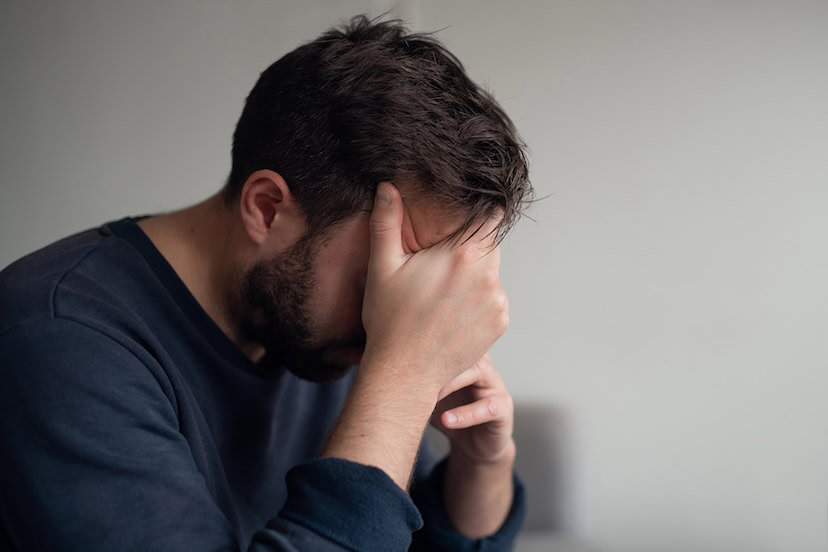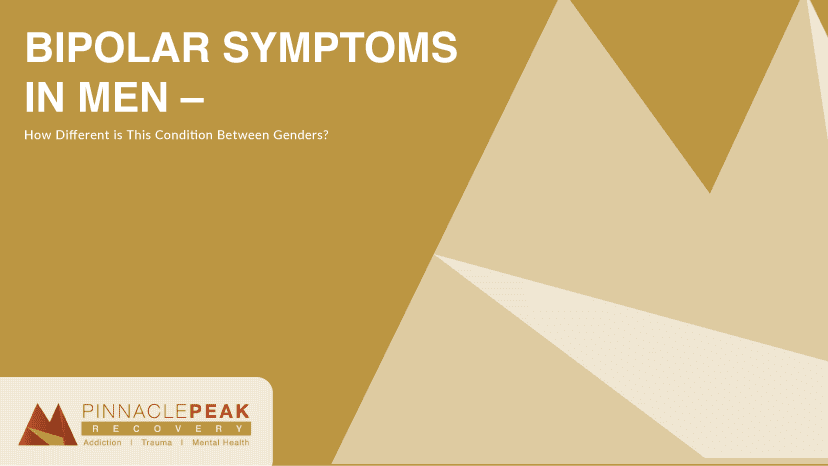You’ve likely walked into a store before and seen products being labeled “for men” or “for women.” Sometimes these are health products, like vitamins, while other times it’s something as simple as mechanical pencils.
Whether these are done for marketing purposes, or for biological reasons, our society likes to have things that are categorized for specific people.
Does this also happen with mental health conditions? How different are our brains, truly?
Over 1 million adults in Arizona have a mental health condition. That’s over half the population of Phoenix alone. Yet so many mental health conditions are misunderstood or are fueled by stigma and misinformation. Our team here at Pinnacle Peak Recovery is experienced in mental health conditions and wants to help our community by spreading awareness about these conditions. Today we’re going to talk about bipolar disorder and, more specifically, bipolar symptoms in men.
How Does Bipolar Disorder Present in Men?
Bipolar disorder is a mental health condition that falls under the classification of a mood disorder. It involves a person experiencing highs and lows at different frequencies. The severity of their symptoms, the length of their episodes, and how frequently they have episodes will determine what type of bipolar disorder they have.
Over the last few decades, the understanding of mental health conditions has grown drastically. Through this understanding, we’ve been able to more accurately determine how mental health conditions impact people. Removing the lens of societal norms, cultural expectations, and gender expectations has helped more people be properly diagnosed and receive the care they deserve.
Previous studies have suggested that one gender experiences psychotic symptoms more frequently than others, while counter-studies have found no difference at all. The condition is still being heavily researched and we’re learning more about it every day.
One study dove into comorbidities in men and women with bipolar disorder, that is what other conditions they have in addition to bipolar disorder. It found that men with bipolar disorder were more likely to have an alcohol or substance use disorder than women.
Let’s touch on what we do know, what we’re certain of, and what differences have or haven’t been noted over time.
The Causes Behind Bipolar Disorder and How They Differ for Men and Women
There isn’t one specific thing that can cause bipolar disorder. Much research is still being done to try and learn more about the source of this condition, but many different factors have been identified over time that generally correlate with the condition.
The primary difference between men and women and what may lead to a bipolar disorder diagnosis varies because of societal differences more than biological ones. For example, women are twice as likely to experience PTSD than men, and trauma can often be a trigger for bipolar disorder, or manic and depressive episodes.
Other factors for developing bipolar disorder include your genetics, your childhood, stress in your life, other mental health conditions, brain injuries, and more.
At the end of the day, there’s a 1:1 ratio of incidence of bipolar disorder in men and women, meaning there isn’t a drastic difference in diagnosis between the two.

Spotting the Different Signs of Bipolar Disorder for Men and Women
Bipolar disorder symptoms can be classified into two categories: depressive symptoms and manic symptoms. These two correlated with the lows and highs of bipolar disorder respectively. In order for these symptoms to be classified as bipolar disorder, they must meet certain severity criteria for not only how they present themselves, but for how long the symptoms last. The periods of time in which these symptoms primarily occur are known as an “episode.”
Outside of these two categories, people with bipolar disorder also have the chance to experience symptoms of psychosis, which can occur because of either type of episode. Psychosis is when someone experiences reality in a way that no one around them does, including hearing or seeing things that aren’t there.
The primary difference between men and women when it comes to bipolar disorder symptoms is that women are more likely to experience depressive episodes than men. This doesn’t mean, however, that men don’t experience depressive episodes.
Let’s take a closer look at what these two categories of symptoms consist of.
Manic Episode Symptoms
- Increased feelings of euphoria, feeling “up” or elated
- Having increased energy levels, including feeling jumpy or wired
- Becoming easily aggravated, having increased irritability, or having a short temper
- Feeling like you need less sleep or having a general disruption in sleep patterns
- Feelings of heightened importance or increased power
- Doing reckless activities like overeating, excessive sex, or spending and giving away lots of money
Depressive Episode Symptoms
- Feeling lost, worthless, or increased feelings of sadness
- Feeling lonely or isolating yourself from others
- Being forgetful, having very little to say, or talking slowly when you do talk
- Sleeping excessively, or feeling overly fatigued
- Lack of interest in things you usually enjoy, finding it difficult to do simple tasks
- Having thoughts of self-harm, suicidal ideation, or even attempting suicide
Mixed episodes are also possible with bipolar disorder. These episodes would include any combination of symptoms from both manic and depressive episodes.
The downtime between episodes can vary from person to person. When someone experiences 4 or more episodes of mania or depression within one year, that is known as “rapid cycling.” Generally, rapid cycling has been reported as more common in women than men.
Do Men Experience More Manic Symptoms Than Women?
Some studies suggest that men experience more manic episodes than women, but others connect it to women simply experiencing depressive episodes more often, making the prior seem true by correlation.
There are differences between men and women that can influence mental health, such as differing common coexisting health concerns. Not only that but men and women tend to showcase signs of mania and depression differently.
Ultimately, there is still much research to be done. The one thing we know to be true is that women with bipolar disorder are more likely to experience depressive episodes than men.
Knowing the Difference Between the Types of Bipolar Disorder
Bipolar disorder is broken down into three kinds. The difference between each consists of what symptoms you experience, how often you experience them, how severe they are, and how long your period of symptoms lasts.
Each type has specific criteria that must be met for you to be diagnosed with that kind of bipolar disorder. We’re going to explain their differences while also touching on whether any of the types appear more frequently in men than women.
Bipolar I Disorder
To have Bipolar I, someone primarily experiences manic episodes that last for at least seven days at a time. During those days they’re experiencing manic symptoms most of the day, nearly every day. If the episodes don’t last that long, but are severe enough to require hospitalization, that can also be indicative of Bipolar I.
People with Bipolar I can also experience depressive episodes, which often last at least 2 weeks. They may also experience mixed depressive episodes, which include overlapping symptoms with manic episodes.
Many past studies suggest Bipolar I is more common in men than women. Studies as recent as 2021, however, are starting to indicate that Bipolar I has no significant gender difference. Research is still ongoing and we’re learning more every day.
Bipolar II Disorder
Those who are diagnosed with Bipolar II have primarily depressive episodes, mixed episodes, or hypomanic episodes which are less severe versions of manic episodes.
Depressive episodes can also lead to hospitalization. This can be due to a lack of self-care or even because of suicide attempts. Being able to spot the signs of depression and learn how to address them can be a big help for those dealing with Bipolar II.
This form of the disorder is primarily associated with women, as women overall have a higher rate of experiencing depression than men. This doesn’t mean men can’t also have Bipolar II.
Cyclothymic Disorder
Also referred to as cyclothymia, this form of bipolar disorder is defined by a combination of recurring hypomanic and depressive symptoms. Neither last long enough or are intense enough, to qualify as full episodes. There is not a known gender difference for cyclothymia.
Alcohol-Withdrawal Only
- Depression
- Mood swings
- Headaches
- Fever
- Fatigue
- Seizures
Both Alcohol-Withdrawal & Anxiety
- Trouble thinking
- Nausea
- Rapid heart rate
- Irritability
- Increased sweating
- Shakiness

Treatment Options Available for Men With Bipolar Disorder in Arizona
Man or woman, you deserve a treatment program that’s going to have you in mind. Finding treatment for bipolar disorder might seem scary, but there are places that want to help. There are facilities that will work with you and craft a treatment plan that offers you the support you need to feel safe inside your mind again.
From inpatient to outpatient and beyond, our team at Pinnacle Peak Recovery is here to help. We want to support you along our evidence-based practice, finding the right fit for your healing journey. If you have any questions or wish to get started today, just give us a call at 866-377-4761.
Clinical Excellence | Compassionate Care | Family Feel

